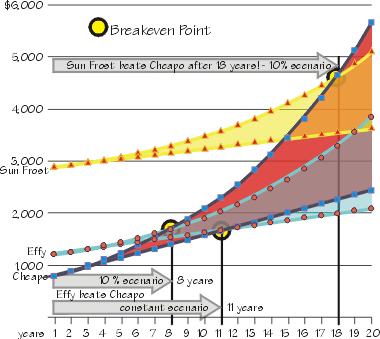
 |
The New Independent Home
by Michael Potts

from chapter 2 :
The Outrageous Cost of Refrigeration |
Why does a home refrigerator cost so much to operate? Familiar answer: The manufacturer pays to build it, but you pay to run it. If you, like the average appliance shopper, base your purchasing decision primarily on sticker price and features, you deserve what you purchase. In private, refrigeration makers are baffled and cynical about the decisions made by what they call the "American housewife," who seems not to notice the cost of the electricity gobbled by the behemoths they build, but demands ice cubes, water, and chilled beverages coming out of little ports on the door. Laughing, they call this "terminal featuritis." If you are working toward energy independence, you buy a small, quiet, efficient cold box. On-the-grid, the true costs and benefits are as usual disguised: Buy the cheap model, which costs much less, and pay more for electricity over time, or buy the more expensive, more efficient unit and within seven or eight years, comparing equipment cost (original purchase price) plus the operating cost (price paid for the electricity consumed), you will break even and be a resource hero. If you keep the refrigerator for twenty years, your total lifetime cost will be half that of the inefficient unit.
Refrigerators and freezers work better when they are full, and this is mostly true, but is not a justification for a large appliance. If too full, the circulation required to keep the whole box cool is defeated, or the fan runs too much. A chest freezer works best if it is packed full, except that it may be slow to reach full cold if a large amount of new food is added at one time; upright freezers lose less cold air every time the door is opened if they are full. But efficiency is not served by buying a unit too big, and then putting things in it that do not require refrigeration -- see the Refrigerator Challenge in the sidebar, and then read about Berta's Monster in chapter 5. It is much cheaper to buy a small efficient unit and use refrigeration intelligently. We get along nicely with an 11-cubic-foot super-efficient unit, and all our brooms, mops, and other long-handled riding equipment fits nicely into the space saved.
|
 | Cost of refrigerator plus electricity over a twenty-year lifetime for three different 19-cubic-foot refrigerator-freezer units -- the lowest-cost model from a reputable manufacturer (Cheapo), the same manufacturer's "high efficiency" unit (Effy), and the absurdly expensive super-efficient Sun Frost. In each case, the lower line represents "constant cost" electricity at today's rates in Caspar, and the upper curve represents the costs with 10% compound rate increases.
Breakeven -- the point at which total costs are equal -- takes place after eight years when the efficient unit becomes less expensive to own than the cheaper unit. The Sun Frost never overtakes the efficient major-manufacturer's unit. In the compound increase scenario, the "budget" refrigerator consumes electricity worth seven times its purchase price during its lifetime. |
|
sidebar:
The Great American Refrigerator Challenge
An iconoclastic colleague at one of my seminars challenged our adult students to take "The Great American Refrigerator Challenge":
Get two large cardboard boxes. Open the refrigerator. (Might as well turn it off, since this may take a while.)
Phase one: Take out everything that has been napping undisturbed in the refrigerator for some arbitrary time (shall we say three months?) and put it in one box. Do the same for the freezer, but perhaps we can agree to a longer threshold, possibly six months. The rules of the Challenge do not provide for leaving time capsules longer than a year in either case.
Phase two: Look quickly in the freezer to see if anything there does not require refrigeration, but there shouldn't be much. You can close the freezer now. While it was open, could you feel the cold pouring out of the freezer door onto your toes? That is why intelligently designed freezers are chests, not upright. Now, remove from the refrigerator everything that requires no refrigeration. If the label says "Refrigerate after opening" assume the maker knows whereof he speaks, but otherwise, into the second box it goes. If not yet opened and not marked "must be refrigerated," it too goes into the second box.
My friend reports that in the majority of Challenges he has administered, more than half of the contents of the refrigerator are now in the boxes. Why should this be? Could it be that we grossly overestimate our need for refrigeration? Could it be that our refrigerators are so big, we have no other place for most of these foodstuffs?
|


|